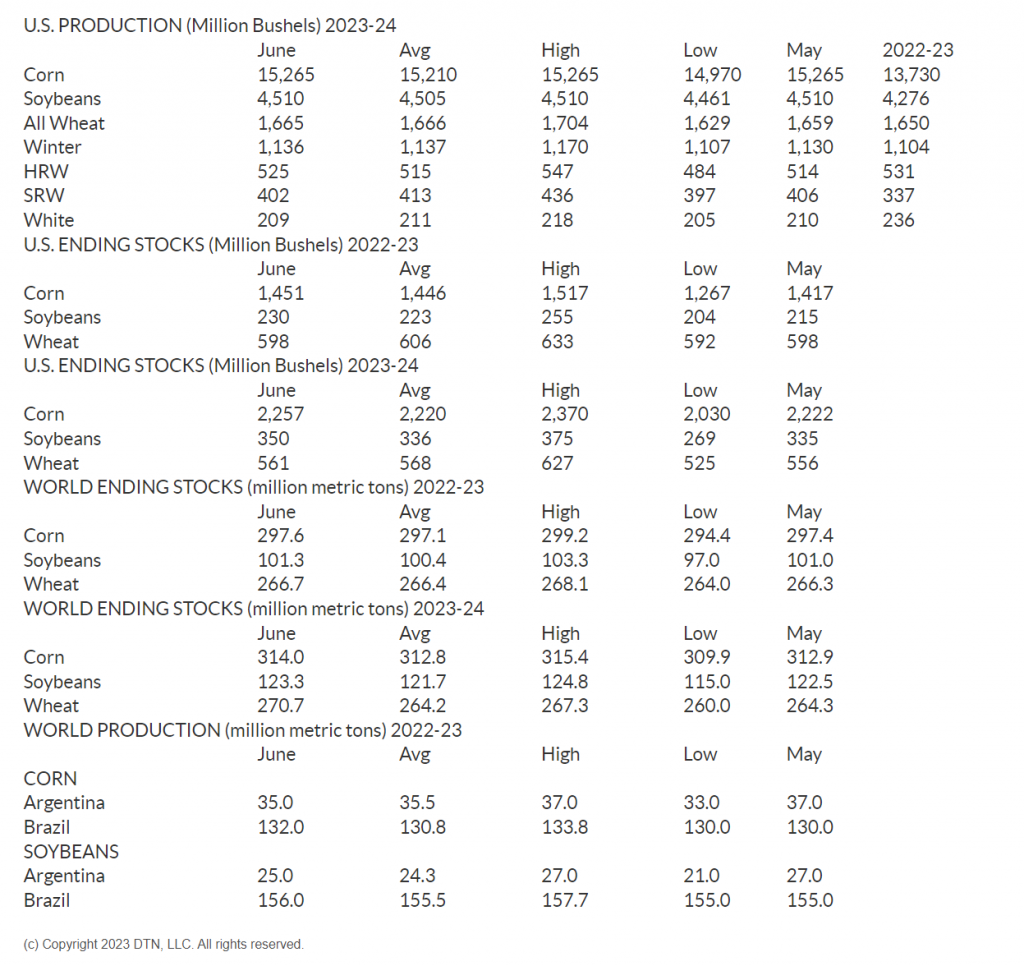
The June World Agricultural Supply and Demand Estimates (WASDE) and Crop Production reports were both released on Friday. Focusing on South American crop production, USDA raised Brazil’s current corn production 2 million metric tons (mmt) and soybean production by 1 mmt while lowering Argentina’s corn and soybean production each by 2 mmt as well.
Farm Director KC Sheperd visited with Allendale’s Rich Nelson and he said USDA left a lot of questions for future reports, “Corn stocks annual crop side they were raised by 15 million bushels. Or 35 million bushels. Now, there’s 1.45 range pretty much what the trade was expecting, and they did leave the new crop numbers unchanged. So still staying with trend yield, which is not unusual for this time of year, as well as harvested acres unchanged. Soybeans, same type of story, in this case, they saw a 15 million bushel increase in stocks now 230, And they as they always do from pretty much on this June report. They left this soybean acreage as well as yields unchanged.”
Nelson said when it comes to Wheat, the report showed a larger movement in terms of discussion, “We did see the all wheat production number in this case raised by 6 million bushels 1.665. They add a little bit to this discussion for hard red wheat based on these recent rains, adding 9 million bushels they are estimating. “
When it comes to Cotton, Nelson said it has been a topic of conversation on the last few reports, “For this month’s report we did see USDA raise the production estimate now going from 15.5 million bales now 16.5 And they chose to add a little bit to ending stocks. 3.3 million bales last month now 3.5. So they did reflect some of the discussion point about a better production picture but a lot of people noting that they really didn’t hit it full steam.”
You can also access the full reports here:
— Crop Production: https://www.nass.usda.gov/…
— World Agricultural Supply and Demand Estimates (WASDE): http://www.usda.gov/…
WHEAT
USDA’s domestic projection of a 1.665 bb new-crop wheat was a slight increase from 1.659 bb in the May report, with average yield set at 44.9 bushels per acre, a slight increase from 44.7 bushels per acre in May. New-crop ending stocks are expected to land at 562 million bushels.
Food, seed, and residual use for new crop is unchanged from May at 1.112 bb, with exports also unchanged at 725 mb.
U.S. farm gate prices were pegged at $7.70, a decrease from $8.00 in the May estimate.
Winter wheat production is forecast at 1.14 bb, up 1% from the May 1 forecast and up 3% from 2022. As of June 1, the United States yield is forecast at 44.9 bushels per acre, up 0.2 from last month but down 2.1 bushels from last year’s average yield of 47.0 bushels per acre.
Hard red winter production, at 525 mb, is up 2% last month. Soft red winter, at 402 mb, is down 1% from the May forecast. White winter, at 209 million bushels, is down 1% from last month. Of the white winter production, 10.3 mb are hard white and 199 mb are soft white.
Globally, USDA pegged new-crop wheat production at 800.19 mmt, up from 789.76 mmt in May, with ending stocks at 270.71 mmt, up slightly from 264.34 mmt last month.
USDA estimates Canada’s wheat crop at 37.0 mmt, Europe at 140.5 mmt and Argentina at 19.5 mmt.
Ukraine’s wheat crop is estimated at 17.5 mmt, while Russia’s crop is estimated at 85.0 mmt.
On China, USDA estimates the nation’s wheat crop at 140.0 mmt after the Henan province was hit by heavy rains.
CORN
The major change for corn in the June report was lowering old crop (2022-23) exports by 50 million bushels (mb) to 1.725 billion bushels (bb) for the year.
That was the key adjustment raising old-crop ending stocks to 1.452 bb, up 35 mb from May.
Carryover increased the 2023-24 new crop total supply by 35 mb to 16.742 bb.
USDA made no other changes to new-crop supply and demand until the ending stocks, which were increased 35 mb to 2.257 bb for the 2023-24 crop.
USDA stuck with its production forecast at a record 15.265 bb despite some early concerns about drought. USDA projects farmers will plant 92 million acres with a record yield of 181.5 bushels per acre.
On the demand side, USDA projects the 2023-24 Food, Seed and Industrial use at 6.735 bb. Ethanol use is forecast at 5.3 billion bushels. Total domestic use is forecast at 12.385 bb. Exports for the new crop are pegged at 2.1 bb.
The farmgate price for the 2023-24 crop is projected at $4.80 a bushel, the same as last month.
Globally, beginning stocks for the 2023-24 new crop were raised slightly to 297.55 million metric tons. Production globally was increased 3.14 mmt to 1,222.17 mmt. Global exports were bumped up 2.5 mmt to 197.76 mmt. Global ending stocks for the new crop are forecast at 313.98 mmt, up 1.08 mmt.
Looking at global 2022-23 crop, Brazil’s production was raised 2 mmt to 132 mmt and exports were increased 2 mmt to 55 mmt. Argentina production was lowered 2 mmt to 35 mmt because of drought concerns, and Argentina’s exports lowered to 23 mmt as well. Ukraine’s production held firm at 27 mmt and Ukraine’s exports were raised 1.5 mmt to 27 mmt.
SOYBEANS
USDA estimates domestic new-crop (2023-2024) soybean production at 4.51 bb, based on 87.5 million planted acres and projected average yield of 52.0 bushels per acre.
USDA set domestic old-crop (2022-2023) soybean ending stocks at 230 mb. New-crop ending stocks were estimated at 350 mb, 15.0 mb higher than the May estimate.
The agency estimates the average farm-gate price for new-crop soybeans at $12.10 per bushel.
Globally, USDA set Brazil’s 2022-2023 soybean crop at 156 mmt. The agency also estimates Argentina’s soybean crop at 25.0 mmt.
Global old-crop world soybean ending stocks were pegged at 101.32 mmt. USDA estimates new-crop ending stocks at 123.34 mmt, an increase from 122.5 mmt in May’s report.
LIVESTOCK
Friday’s WASDE report was supportive for the beef and cattle markets, although it didn’t share much new news to speak of. Beef production for 2023 was raised slightly as throughput is expected to remain snappy on both fed and non-fed cattle classes. Beef production for 2023 grew by 165 million pounds from last month’s report.
Quarterly steer prices were raised from last month as relentless beef demand and thin supplies continue to push the cash market to new all-time highs. For 2023, the second quarter is estimated to average $179, which is $7.00 higher from last month, the third quarter is expected to average $173, which is $9.00 higher than last month, and the fourth quarter is expected to average $174, which is $5.00 higher than last month. There were no changes made to beef imports or exports compared to a month ago. 2023 beef imports are expected to total 3,501 million pounds, and exports are expected to total 3,224 million pounds.
Friday’s WASDE report could be viewed as neutral for the hog and pork markets. Pork production for 2023 was slightly lower, although processing speeds continue to be vigorous, carcass weights have declined. Pork production for 2023 was decreased by 5 million pounds from last month’s report.
Quarterly hog prices remained unchanged from a month ago expect in the second quarter of 2023, which saw a $1.00 price increase to now average $57, the second quarter remained steady at $60 and the third quarter remained steady at $55.
Pork imports remained steady at 1,069 million pounds, but 2023 exports did increase by 300 million pounds to now total 6,803 million pounds.















